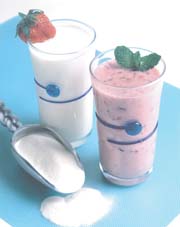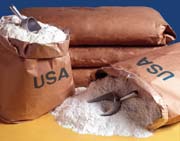U.S. dairy exports increased 31% in 2004, to record-high volume of 1.562 billion lbs. of milk solids, reports the U.S. Dairy Export Council (USDEC). The value of 2004 U.S. dairy exports jumped 39% to $1.49 billion.
"U.S. suppliers took advantage of favorable market conditions to expand exports in 2004. In fact, we saw what many believed was a theoretical impossibility: Strong U.S. dairy exports in the presence of firm U.S. domestic market prices," says USDEC President Tom Suber.
In early 2005, results for ingredients are equally positive. In the first five months of this year, export volume of skim milk powder (SMP), whey and lactose grew 67% to 746.5 million lbs. when compared to the same 2004 period, according to USDA's Foreign Agriculture Service (FAS). The overall value of U.S. dairy exports reached $723.9 million, FAS says, up 38% from last year's record pace.
Dairy exporters predict the world market will become increasingly important to U.S. dairy companies; 2004 exports made up 7.4% of the nation's milk solids production, compared with 5.6% in 2003.

Core Market
Exports have become a core market for many of the key U.S. dairy players, says Jerry O'Dea, president of Monroe, Wis.-based Glanbia Nutritionals Americas, a major U.S. exporter of lactose, WPCs, WPIs, lactoferrin and milk calcium."USDEC provides the help and the resources such as offices around the world, and works alongside us in developing the markets on sort of a macro level, creating a better image for U.S. suppliers. Meanwhile, the suppliers work on specifics with the customers," O'Dea says.
Arden Hills, Minn.-based Land O'Lakes sends 30 to 35% of its whey production to the world market and additionally has a good presence in value-added ingredients, says Keith Grove, Land O'Lakes managing director of dairy proteins, international ingredients and aseptic products. LOL was among the first U.S. companies to sell significant amounts of dairy products overseas. "It doesn't take a genius to see if we don't market internationally, our domestic market is going to be in the tank," Grove says.
"We're exporting 30% of our production of whey and SMP products, and with good returns," adds Gabriel Sevilla, v.p. of international sales for Kansas City, Mo.-based Dairy Farmers of America. DFA's main exports are whey, whey proteins and demineralized whey; as opportunities arise. DFA also exports cheese and other dairy products.
Already among the most efficient milk producers in the world, the United States has the ability to raise its milk production to meet world demand, exporters agree.
"The United States still has abundant resources to expand its future production and supplies for export, which means we have the commercial potential to step in to replace traditional sources of traded dairy products," says Phil Smith, Leprino Foods Co.'s v.p. of marketing and sales, whey products. Denver-based Leprino has been involved in the export market for more than 25 years, with exports of whey products, WPC and lactose.
Continued U.S. export growth opportunities abound, particularly in light of growing economies and more liberalized trading rules. "That's a positive in terms of the U.S. dairy export business as well as for world economies," Grove says.

Rising Demand
In fact, expanding demand is perhaps the most important factor of all. Consumption of dairy products has grown as the world standard of living rises, helping the United States become more competitive for SMP and whey products, Smith notes. U.S. export prices will become more attractive across other dairy segments as trade-distorting export subsidies and duties continue to fall or are eliminated, Smith says.Export growth is likely to benefit from the efforts of New Zealand and Australia to make use of their tight milk supply to shift to a higher-value product mix, exporters agree. "We've seen recent opportunities in South America that were previously taken by New Zealand and Australia," Grove says.
From Latin America to Southeast Asia, growing U.S. dairy export sales are expected. Even the Middle East and South America are becoming more desirable markets due to their increasingly stable economies.
The traditional markets in Asia, such as Japan and Korea, are expected to continue to be valuable, not only as customers, but also as a template for successful dairy ingredient applications elsewhere, exporters agree.
For instance, with protein supplements, U.S. suppliers can cite product examples from other markets as well as share successful consumer marketing messages, O'Dea adds. "You don't want to reinvent the wheel."
SMP Power
The biggest gainer in the 2004 export market was skim milk powder. In fact, one of the key factors behind the growth of U.S. exports was processors' willingness to produce skim milk powder to world market specifications by standardizing the protein, instead of simply making what is traditionally called nonfat dry milk. International SMP sales by U.S. exporters jumped 75%, a significant development, as most of the sales were not supported by the Dairy Export Incentive Program.Indeed, in the second half of 2004, the United States became the world's primary SMP supplier. Shipments to Mexico-the largest U.S. dairy export market-were up 56%, and sales to the second-largest region-Southeast Asia-were nearly triple the amount sold in 2003.
A combination of reduced subsides from the EU and a change in Oceania production to more whole milk products to supply China are some of the market dynamics that led buyers to turn to the United States, Grove says.

High Value
The international demand for high-value U.S. dairy proteins and co-products, such as WPCs and WPIs, continues to grow. Five years ago, two-thirds of U.S. whey exports were sweet whey. Today, about half is sweet whey and half is higher-value WPCs and WPIs.Awareness building and promotion of the benefits of whey proteins and various nutritional and pharmaceutical applications by stateside dairy organizations, including USDEC and Dairy Management Inc., are major contributors to the trend, exporters agree.
Economics in emerging markets are also a factor, says David Curta, international sales mgr. for Davisco Foods. "We're seeing China's economy growing 8 to 9% annually. As the incomes grow, people are consuming more ready-to-drink (RTD) beverages, infant formula; things they couldn't afford before. They could previously only buy very low quality product, but as more multinationals come in, using more premium ingredients, domestic companies follow their lead."
Davisco has carved out a niche in the world market for value-added, high protein ingredients by isolating proteins and sub-proteins to a very high level. Applications include infant formula, where processors are reviewing the amino acid profile to achieve formulations that are very close to mothers' milk, Curta notes.
"Companies have been trying to make do with sweet dairy whey, lactose, and WPC," Curta continues. "They may not need such a high level of purity for their formulas, but we are making companies aware that these kinds of products are now available, and they can put together the puzzle."
Whey protein is emerging as a mainstream protein in the United States, O'Dea reports. He cites the addition of 5-lb. cans of whey as beverage supplements to mainstream venues like Costco and Sam's Club stateside, with a similar phenomenon in Japan, proving acceptance at home leads to marketing applications abroad.
"Whey protein used to be a niche for muscle building. In today's post-Atkins world, people realize there is a need to cut back on the carbs," O'Dea says. "Awareness of whey protein is going to spill over into the emerging markets and even European countries, where they are watching the trends in the United States."
Dairy Taps Nutri-Marketing
Some of the most exciting developments in whey product marketing are in "nutri-marketing" categories, which build on prior success in the sports nutrition channels and ongoing research to tie whey to weight management, improved immunity function, reduced blood pressure, and even as a sleep aid.Though the matter of affordability is an issue, as economies in emerging markets grow, the nutrition-marketing niche will become more prevalent, Grove says.
While weight management traditionally stressed weight loss on a ‘what-the-scale-told-you' basis, today there's more awareness of overall body composition carried over from sports nutrition, O'Dea says. "With many diets, the loss of weight was actually loss of lean muscle."
Whey protein research is showing effectiveness at fat loss, which may yield slower weight loss, but is overall a healthier and longer-lasting alternative. In addition, whey offers satiety qualities, which help appetite control. "As more of the consumer market understands these benefits and advantages, it will really be positive for whey to be involved in a broad weight management effort," O'Dea says.
The nutrition bar segment has long been a carrier of whey products, but annual growth of 20 to 30% has slowed, O'Dea says. Now, that sort of growth rate is instead seen in the functional beverage segment, where whey also plays a key role. In addition to a growth market for RTD protein shakes, dairy-based smoothies and other beverages, opportunities are available in single-serve packages of dry beverage mixes.
"Packaging technology that allows production of shelf-stable, aseptic RTD products in plastic hasn't previously been available. It helps make whey-fortified beverages more attractive and more appealing to the consumer," O'Dea says.
Exporters agree it is critical to the continued success of U.S. exports to prove out some of these nutritional claims through clinical research (see sidebar, page 45). A coordinated approach to the international marketplace, including collaborative research, management of intellectual property and joint development of FDA health claims, provide opportunities to raise the profile of whey to a higher level, O'Dea says. Exporters agree that such efforts will be highly involved and expensive, but worth the investment.
"As an industry we've been very fragmented, and we've not ponied up for the clinical research to prove the efficacies of our products. Other industries, such as the soy industry, have already done so," Grove notes. "There's universal advantage, so why not make it a universal effort?"

Lactose Market
A 62% gain in sales to China helped propel U.S. lactose exports to 343.4 million lbs. in 2004, a 9% increase over 2003. Increases in the world's largest lactose market, Japan, as well as in Mexico, Southeast Asia, South America and Canada, served to counter a large drop-off in lactose sales to New Zealand.With the reduction of high tariffs, China has become a significant market for U.S. lactose. "They have gone from importing less than a few hundred tons to importing thousands and thousands of tons. In some cases, when pricing is favorable, lactose is replacing whey as an ingredient," Curta says.
Currently, the United States is setting the price structure for the lactose market, and its share of global lactose trade-estimated to be about 40%-will continue to expand, Smith says. "The United States has become the most competitive and largest source for dairy carbohydrates in the forms of lactose and permeate powders," he adds.
Traditional human uses for lactose include confectionery and infant formula, with exporters earmarking growth potential in pharmaceutical applications, as well as for use as a bulking agent in food products.
The feed market continues to have bright prospects. Lactose feed additives are currently reserved for young pigs in China, but when the market expands to include adult animals, the weight-based feed formula means the United States can expect to see what Curta dubs a "huge" increase in lactose demand.
Outlook is Positive
Challenges and opportunities lie ahead for U.S. dairy exporters as world market access improves."Our recent success tells us that trade agreements work," Suber notes. For instance, exporters are expanding sales to Mexico, where NAFTA gives U.S. suppliers a large competitive advantage; Chile, where access increased following completion of a bilateral trade agreement; and China, where import tariffs have come down to meet World Trade Organization (WTO) commitments.
"As world dairy trade becomes more transparent and open, the United States becomes a stronger force because of our experience competing in our domestic market," says Smith.
Much hinges on the upcoming WTO round (see news story, page 22); the U.S. industry is fully behind the government's push for elimination of export subsides (particularly in the EU) and more equitable levels of market access barriers.
US exporters should continue to develop a full complement of dairy ingredients and grades to prepare for the expected ongoing reduction of international trade subsidies and tariffs, O'Dea says.
In fact, improved trading rules, coupled with rising demand, will lead to increased global trade in dairy products, according to UK-based Landell Mills Management Consultants.
"Demand for internationally traded dairy commodities is likely to increase by over 1 million tons of dairy products by 2010, from a current base of 5 million tons," says Ross Christieson, a director of Landell Mills. "Meanwhile, supply from non-U.S. dairy suppliers is likely to increase by less than 450,000 tons in the same timeframe. A substantial demand gap exists, and only the U.S. dairy industry is in a position to fill this gap in global demand," he says.
Mindful of this opportunity, U.S. dairy exporters are re-orienting their thinking. "The export market is not a destination of last resort for products you cannot sell domestically," says Sevilla. "In fact, today's export market often offers a greater return than the domestic market. We're treating our export markets as valuable customers, rather than as a last resort as in past years."
Alan Levitt is president of Levitt Communications, a Crystal-Lake, Ill.-based firm specializing in market analysis and marketing communications for the dairy industry. He has been providing commentary on the dairy industry for the last 20 years, including a stint on the Dairy Foods editorial staff from 1985-1990.

Sidebar: Whey Seeks to Stake Its Health Claim
Word of whey's beneficial health effects has been circulating for years. Trouble is, that's all it's been just that: Words. Available scientific proof is insufficient to actually make a health claim on a food product's package under FDA guidelines or even assert a link between whey product consumption and any disease or medical condition.The U.S. Whey Protein Research Consortium hopes to change all that. The Consortium is an unprecedented unified effort of industry players working together in a pre-competitive manner to support clinical trials aimed at earning an FDA-approved health claim. It includes whey processors, multinational food marketers, and industry organizations, including the U.S. Dairy Export Council and Dairy Management, Inc. Because the initiative could have a global impact, the Consortium is seeking to work with other whey-producing entities and associations in other parts of the world to leverage resources, share knowledge, and accelerate the pace of new discoveries.
One of the Consortium's first orders of business is backing research into how whey protein might affect body weight and fat. Scientists believe whey protein may alter muscle metabolism, leading to a decrease in fat and an increase in lean muscle mass. Improvement in body composition and weight may, in turn, reduce the risk of chronic degenerative diseases-like cardiovascular disease and diabetes-that can contribute to early death.
Initial clinical studies comparing whey protein to soy protein and an isocaloric control product have been completed. The results are still being analyzed, but more research is already in the works.
Ultimately, the Consortium aims to create a pipeline of projects that bolster the value of whey by demonstrating health-enhancing properties. If the research proves out, it will not only give dairy a competitive edge over protein alternatives on the market, it will directly benefit U.S. processors as the United States is one of the biggest producers of whey proteins and largest single exporter. But most importantly, if the research supports scientists' hypotheses, it could benefit millions of people worldwide suffering from obesity, sarcopenia, and other dangerous health conditions.
